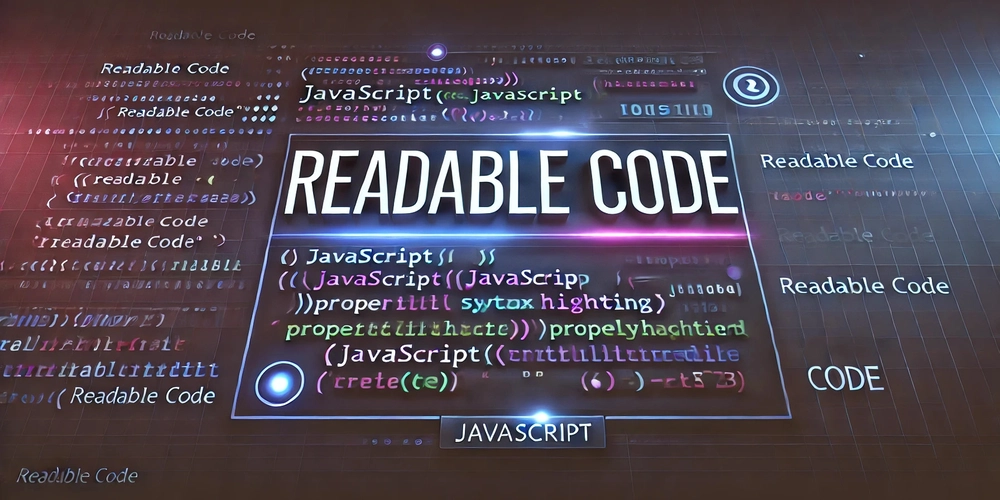Writing Human-Readable Code: Best Practices for Clean & Maintainable Code
Introduction Writing code that is efficient and functional is essential, but ensuring that it is human-readable is just as important. Readable code enhances collaboration, reduces debugging time, and makes maintaining software easier for both the original developers and future ones. In this article, we will explore best practices for writing human-readable code. 1. Use Meaningful Variable and Function Names Why It Matters: Descriptive names make it easier to understand the purpose of variables, functions, and classes without requiring additional comments or explanations. Best Practices: Use clear, descriptive names that explain their purpose. Follow standard naming conventions (e.g., camelCase in JavaScript, snake_case in Python). Avoid using single-letter variable names, except in specific cases like loop indices (i, j). Use verbs for functions (e.g., calculateTotal() instead of total()). Example: # Bad def ct(a, b): return a + b # Good def calculate_total(price, tax): return price + tax 2. Keep Functions and Methods Short and Focused Why It Matters: Short, well-defined functions improve readability and reusability. Best Practices: Follow the Single Responsibility Principle (SRP) – a function should do one thing and do it well. Keep functions within 20-30 lines where possible. Break down complex operations into multiple smaller functions. Example: // Bad: Too much logic in one function function processUserData(user) { let fullName = user.firstName + " " + user.lastName; let age = new Date().getFullYear() - user.birthYear; console.log(`User: ${fullName}, Age: ${age}`); } // Good: Separation of concerns function getFullName(user) { return `${user.firstName} ${user.lastName}`; } function calculateAge(birthYear) { return new Date().getFullYear() - birthYear; } function printUserInfo(user) { console.log(`User: ${getFullName(user)}, Age: ${calculateAge(user.birthYear)}`); } 3. Use Comments Wisely Why It Matters: Comments provide context but should not replace self-explanatory code. Best Practices: Write why the code does something, not what it does. Avoid redundant or obvious comments. Use docstrings or JSDoc-style comments for functions and modules. Example: // Bad: Redundant comment int age = 25; // Assigns 25 to the variable age // Good: Explains why a condition exists // Prevent division by zero if (denominator != 0) { result = numerator / denominator; } 4. Maintain Consistent Formatting and Structure Why It Matters: Consistent formatting makes code easier to read and navigate. Best Practices: Use consistent indentation (e.g., 4 spaces in Python, 2 spaces in JavaScript). Follow a standard coding style guide (e.g., PEP8 for Python, Airbnb for JavaScript). Organize code into logical sections. Example: # Bad: Inconsistent indentation if is_valid: print("Valid") print("Processing...") # Good: Consistent indentation if is_valid: print("Valid") print("Processing...") 5. Use Proper Error Handling Why It Matters: Proper error handling prevents unexpected crashes and improves maintainability. Best Practices: Use try-catch blocks to handle exceptions gracefully. Provide meaningful error messages. Avoid catching general exceptions (e.g., catching Exception in Python or catch (error) in JavaScript without handling it properly). Example: # Bad: Generic exception handling try: result = 10 / 0 except Exception: print("An error occurred") # Good: Specific exception handling try: result = 10 / 0 except ZeroDivisionError: print("Cannot divide by zero") 6. Follow the DRY (Don't Repeat Yourself) Principle Why It Matters: Avoiding redundancy reduces maintenance effort and minimizes the risk of inconsistencies. Best Practices: Extract repeated logic into functions or modules. Use constants instead of magic numbers. Prefer inheritance and composition in object-oriented programming. Example: // Bad: Repeating logic console.log("Welcome, John Doe!"); console.log("Welcome, Jane Doe!"); // Good: Using a function function welcomeUser(name) { console.log(`Welcome, ${name}!`); } welcomeUser("John Doe"); welcomeUser("Jane Doe"); 7. Write Meaningful Tests Why It Matters: Well-written tests ensure code reliability and prevent regressions. Best Practices: Use descriptive test names. Test both expected and edge cases. Follow the AAA (Arrange, Act, Assert) pattern. Example: # Bad: Unclear test assert add(2, 3) == 5 # Good: Descriptive test name def test_addition_of_two_numbers(): assert add(2, 3) == 5 Conclusion Writing human-readable code is not just about personal preference—it’s about collabora

Introduction
Writing code that is efficient and functional is essential, but ensuring that it is human-readable is just as important. Readable code enhances collaboration, reduces debugging time, and makes maintaining software easier for both the original developers and future ones. In this article, we will explore best practices for writing human-readable code.
1. Use Meaningful Variable and Function Names
Why It Matters:
Descriptive names make it easier to understand the purpose of variables, functions, and classes without requiring additional comments or explanations.
Best Practices:
- Use clear, descriptive names that explain their purpose.
- Follow standard naming conventions (e.g., camelCase in JavaScript, snake_case in Python).
- Avoid using single-letter variable names, except in specific cases like loop indices (
i,j). - Use verbs for functions (e.g.,
calculateTotal()instead oftotal()).
Example:
# Bad
def ct(a, b):
return a + b
# Good
def calculate_total(price, tax):
return price + tax
2. Keep Functions and Methods Short and Focused
Why It Matters:
Short, well-defined functions improve readability and reusability.
Best Practices:
- Follow the Single Responsibility Principle (SRP) – a function should do one thing and do it well.
- Keep functions within 20-30 lines where possible.
- Break down complex operations into multiple smaller functions.
Example:
// Bad: Too much logic in one function
function processUserData(user) {
let fullName = user.firstName + " " + user.lastName;
let age = new Date().getFullYear() - user.birthYear;
console.log(`User: ${fullName}, Age: ${age}`);
}
// Good: Separation of concerns
function getFullName(user) {
return `${user.firstName} ${user.lastName}`;
}
function calculateAge(birthYear) {
return new Date().getFullYear() - birthYear;
}
function printUserInfo(user) {
console.log(`User: ${getFullName(user)}, Age: ${calculateAge(user.birthYear)}`);
}
3. Use Comments Wisely
Why It Matters:
Comments provide context but should not replace self-explanatory code.
Best Practices:
- Write why the code does something, not what it does.
- Avoid redundant or obvious comments.
- Use docstrings or JSDoc-style comments for functions and modules.
Example:
// Bad: Redundant comment
int age = 25; // Assigns 25 to the variable age
// Good: Explains why a condition exists
// Prevent division by zero
if (denominator != 0) {
result = numerator / denominator;
}
4. Maintain Consistent Formatting and Structure
Why It Matters:
Consistent formatting makes code easier to read and navigate.
Best Practices:
- Use consistent indentation (e.g., 4 spaces in Python, 2 spaces in JavaScript).
- Follow a standard coding style guide (e.g., PEP8 for Python, Airbnb for JavaScript).
- Organize code into logical sections.
Example:
# Bad: Inconsistent indentation
if is_valid:
print("Valid")
print("Processing...")
# Good: Consistent indentation
if is_valid:
print("Valid")
print("Processing...")
5. Use Proper Error Handling
Why It Matters:
Proper error handling prevents unexpected crashes and improves maintainability.
Best Practices:
- Use try-catch blocks to handle exceptions gracefully.
- Provide meaningful error messages.
- Avoid catching general exceptions (e.g., catching
Exceptionin Python orcatch (error)in JavaScript without handling it properly).
Example:
# Bad: Generic exception handling
try:
result = 10 / 0
except Exception:
print("An error occurred")
# Good: Specific exception handling
try:
result = 10 / 0
except ZeroDivisionError:
print("Cannot divide by zero")
6. Follow the DRY (Don't Repeat Yourself) Principle
Why It Matters:
Avoiding redundancy reduces maintenance effort and minimizes the risk of inconsistencies.
Best Practices:
- Extract repeated logic into functions or modules.
- Use constants instead of magic numbers.
- Prefer inheritance and composition in object-oriented programming.
Example:
// Bad: Repeating logic
console.log("Welcome, John Doe!");
console.log("Welcome, Jane Doe!");
// Good: Using a function
function welcomeUser(name) {
console.log(`Welcome, ${name}!`);
}
welcomeUser("John Doe");
welcomeUser("Jane Doe");
7. Write Meaningful Tests
Why It Matters:
Well-written tests ensure code reliability and prevent regressions.
Best Practices:
- Use descriptive test names.
- Test both expected and edge cases.
- Follow the AAA (Arrange, Act, Assert) pattern.
Example:
# Bad: Unclear test
assert add(2, 3) == 5
# Good: Descriptive test name
def test_addition_of_two_numbers():
assert add(2, 3) == 5
Conclusion
Writing human-readable code is not just about personal preference—it’s about collaboration, maintainability, and long-term efficiency. By following best practices like using meaningful names, keeping functions concise, writing clear comments, and maintaining consistency, developers can ensure that their code is both functional and easy to understand.
Happy coding!




















































%20Abstract%20Background%20112024%20SOURCE%20Amazon.jpg)






















































































































![[The AI Show Episode 142]: ChatGPT’s New Image Generator, Studio Ghibli Craze and Backlash, Gemini 2.5, OpenAI Academy, 4o Updates, Vibe Marketing & xAI Acquires X](https://www.marketingaiinstitute.com/hubfs/ep%20142%20cover.png)
























































































































































































































































-Nintendo-Switch-2-–-Overview-trailer-00-00-10.png?width=1920&height=1920&fit=bounds&quality=80&format=jpg&auto=webp#)





















_Anna_Berkut_Alamy.jpg?#)













































































































![YouTube Announces New Creation Tools for Shorts [Video]](https://www.iclarified.com/images/news/96923/96923/96923-640.jpg)





































































![[Weekly funding roundup March 29-April 4] Steady-state VC inflow pre-empts Trump tariff impact](https://images.yourstory.com/cs/2/220356402d6d11e9aa979329348d4c3e/WeeklyFundingRoundupNewLogo1-1739546168054.jpg)





























































